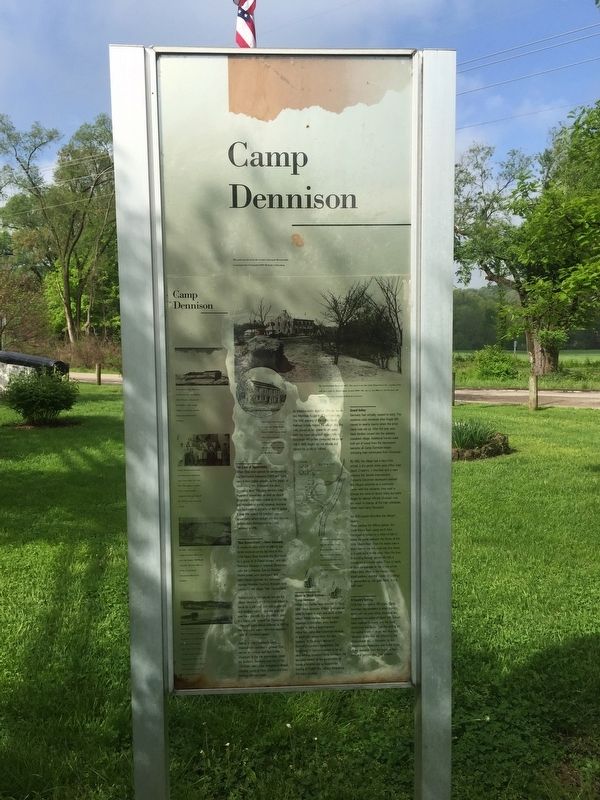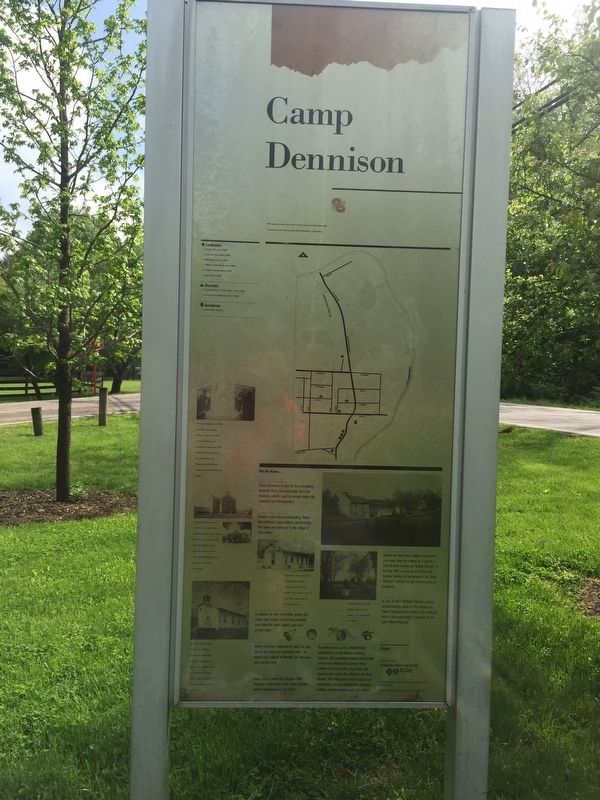Near Milford in Hamilton County, Ohio — The American Midwest (Great Lakes)
Camp Dennison
The Land of Opportunity
When Ohio was opened for settlement by the Northwest Ordinance (1787) and made secure from Indian attacks by the Treaty of Greenville (1795), it became the new “Promised Land.” The new territory lured frustrated easterners as well as recent emigrants who were unable to fit into the well-established social, religious, business and land owning-owning patterns of the 13 states. It was this search for freedom and opportunity which brought the first German settlers from Pennsylvania to Camp Dennison in 1796.
“Neu Deutschland” – New Germany
A couple of miles north of Milford, the fertile land at the big bend in the Little Miami River became the final home to a group of 20 Pietist families who left Germany because of religious differences with the Lutherans. Led by Christian Waldschmidt, who purchased land (from John Cleves Symmes), the Germans founded Hamilton County’s first and most successful mill village, “Neu Deutschland.”
Waldschmidt systematically laid out the village, rerouted part of the Little Miami to serve as a millrace, and built a gristmill and distillery (which used the grain left over from the mill). In the early 1800’s, cloth and fulling mills (were the fabric was stretched) were added, followed in 1810 by the area’s first paper mill which supplied most of Cincinnati’s paper. Seeing to every resident’s needs, Waldschmidt operated a general store, served as minister and saw to the education of the mill apprentices. Under his guidance, Germany was one of the Cincinnati area’s most prosperous villages, shipping goods to New Orleans and from there to the east coast.
At Waldschmidt’s death in 1814, his son-in-law Matthais Kugler took over the mills. The 1842 opening of the Little Miami Railroad initially helped the village, but the mills proved unable to compete with the more advanced steam mills in Cincinnati. When fire destroyed the paper mill in 1848, Kugler did not rebuild, and moved his family to Milford.
Home to Ohio’s Soldiers – Camp Dennison
When Fort Sumter was attacked in April 1861, Ohio Governor William Dennison set aside over $1 million to train and outfit 10,000 troops. While various volunteers troops were organized in Cincinnati, army leaders decided to place a large transient instruction camp near Cincinnati because of good train connections, but also because of the army’s distrust of Kentucky’s southern sympathies. The broad land of Germany proved to be an ideal setting; renamed Camp Dennison, the land was leased by the government to house a hospital and to support the training of 75,000 Ohio soldiers throughout the war’s duration.
Grand Valley
Germany had virtually creased to exist. The residents who reminded after Kugler left moved to nearby towns when the army camp was set up. After the war, areas black families moved into the sparsely populated village. Additional homes were built out of wood from the demolished barracks as Camp Dennison began attracting train commuters from Cincinnati. By 1890, the village had a new brick school, a dry goods store, post office, train depot, 2 taverns, 2 churches, and a new industry, the Granite Improvement Company. Cincinnati developers realized the village’s potential as a commuter town; with the residents, they tried to change the name to Grand Valley but were fought by the railroad officials (it would cost too much to change all the train schedules which read Camp Dennison). An 1878 traveler describes the village’s beauty: “After passing the Milford station, the ‘Little Miami Train’ going north from Cincinnati is forced by a chain of hills to follow for some distance the bends of the Little Miami River. Then the tracks take a sharp turn to the left while the river flows in a wide bend to the west. Now the train is shooting through gentle hills into a wonderful and fertile valley. There is hardly a place comparable to this in the whole Miami area. Most of the houses have small gardens, and the cluster of buildings is surrounded by rich grain fields. It is a quiet nest.”
A Country Setting
Little has changed in 100 years. Camp Dennison has remained a small country town with its post office, churches, and integrated population of about 300. Canoes have replaced flatboats, and once active train tracks are now the setting for quieter travel of hikers and bicyclists. Glimpses of the past are offered by the Waldschmidt House Museum, by the Schoolhouse Restaurant, and in the faces of the residents who are proud of their past and content with their present.
Back Side of Marker
Did You Know…
Camp Dennison is part of, but completely separate from, the once large Symmes Township which used to include Indian Hill, Loveland, and Montgomery.
People in the towns surrounding “New Deutschland” had problems pronouncing the name and referred to the village as “Dutchland”
In addition to corn and other grains, the valley was known for its fruit orchards with plentiful apple, peach, pear, and cherry trees.
When Christian Waldschmidt died, he was one of the County’s richest men; his estate was valued at $46,000, an immense sum for the time.
Route 126 is called the Wooster Pike because it was part of the state turnpike system established in the 1830’s.
To transport his goods, Waldschmidt established a small flatboat building industry. His sawmills produced the lumber which was fashioned by expert boat makers who might also have been coopers who made whiskey and flour barrels. The village also had a number of tradesmen such as blacksmiths, harness makers, cabinetmakers, and cartwrights.
Before the first white settlers came, the area was used by Indians s a granary and became known as “Turkey Bottom” in the late 1700’s because of all the wild turkeys feeding on the grains in the fields. “Bottom” referred to the bottomlands or lowlands.
In July of 1863, Morgan’s Raiders passed embarrassingly close to the garrison at Camp Dennison and without any challenge burnt a locomotive and 3 coaches of the Little Miami Railroad.
Topics. This historical marker is listed in these topic lists: Industry & Commerce • Settlements & Settlers. A significant historical month for this entry is April 1861.
Location. 39° 11.364′ N, 84° 17.514′ W. Marker is near Milford, Ohio, in Hamilton County. Marker is at the intersection of Glendale Milford Road (Ohio Route 126) and E; Galbraith Road, in the median on Glendale Milford Road. Touch for map. Marker is at or near this postal address: 7270 Glendale Milford Rd, Camp Dennison OH 45111, United States of America. Touch for directions.
Other nearby markers. At least 8 other markers are within one mile of this marker, measured as the crow flies. A different marker also named Camp Dennison (a few steps from this marker); a different marker also named Camp Dennison (a few steps from this marker); Dr. Alfred Buckingham (a few steps from this marker); Camp Dennison Civil War Museum (about 700 feet away, measured in a direct line); Richard Michael Weaver (approx. 0.3 miles away); Waldschmidt Cemetery (approx. 0.4 miles away); First Methodist Church (approx. 0.9 miles away); Promont (approx. one mile away). Touch for a list and map of all markers in Milford.
Credits. This page was last revised on January 26, 2023. It was originally submitted on May 24, 2019, by Steve Stoessel of Niskayuna, New York. This page has been viewed 811 times since then and 124 times this year. Photos: 1, 2. submitted on May 24, 2019, by Steve Stoessel of Niskayuna, New York. • Bill Pfingsten was the editor who published this page.

